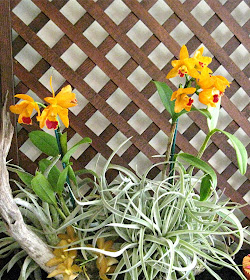

We're having a good cold rain today and the most colorful flowers I see out the windows are potted pelargoniums on the deck railings and Japanese anemones throughout the garden. Fall camellias are starting to open and various asters are close to their peaks on one side or the other. It's a good rain particularly in light of the huge planting project many of us participated in yesterday at the Arboretum.
Religion and politics are good topics to avoid when the family gets together for Thanksgiving dinner. Along those lines, when the subject of double versus single flowers arises in conversation amongst a group of gardeners, it pretty generally heats up the discussion. Some topics just seem to roil our psyches, bringing powerful feelings from the depths to the surface. I'm a person who generally prefers to avoid confrontation and there are some topics: native plants; global warming; orange flowers, though not so much lately; inorganic versus organic fertilizers are a few, that set off warning alerts in my head.
I'm guessing we've all heard friends rage against the gratuitous creation of double-flowered forms of every garden plant. I don't think all doubles are bad but I do wonder why it's so much easier to buy a double kerria, than the wonderful single form. I much prefer the single Japanese anemones to the doubles, at least on those varieties where the flowers sit atop the plants on long peduncles. The singles float lightly in the air while the doubles just seem clunky. I'm definitely not ready to give up most of my roses, though I do grow and like a few singles. I think we can all agree there are double Echinaceas that really ought not to be.
While I don't generally consider myself a pragmatist, my position on double flowers is not philosophical and experience has taught me that there are sometimes advantages to single flowers. Single peonies can hold their heads up in the rain where their showier siblings require quite a bit of tedious and elaborate support. When I was younger I was an Estate Gardener in a large garden in Washington, DC. I inherited a wonderful planting of mature peonies; they were a favorite of the owners. Anticipating spring rains, at a not inconsiderable cost, I bought large strong peony rings. I was careful to put the rings out early enough for the foliage to grow through them and I raised the rings assiduously as the season progressed. Even so many of the heavier flowers overburdened their stems. You can't stake 1,000 stalks....well not reasonably. Still, I wouldn't give up double peonies.
Right now my specimen pelargoniums are flowering wonderfully and so are Japanese anemones., which, I guess, brought the whole double/single thing to mind. I grow only single or barely double pelargoniums in part because the flowers last much longer. Wherever the petals touch, in the presence of the least bit of water, they brown out. Even my singles require regular cleaning. Doubles are hopeless.

 We celebrated Ed Aldrich's 50th birthday at the Plant Exchnge. Ed stands unequaled atop the pyramid of those of us in the DC area that grow hardy tropicals. Or at least unsurpassed. He also stands in the top picture describing one of the many plants he brought to the exchange.I didn't bother to move away from his contributions. We take turns; I had the 19th turn and took Alpinia caerulea from amongst his plants, then Dyckia altissima, and Agave 'Mr. Ripple', Mimosa borealis, Sesbania sp., all from amongst his contributions. Karen got a Russian Pomegranate and an Acer griseum. Someone contributed this huge collection of floral arranging paraphernalia including dozens of frogs. We took a couple of them.
We celebrated Ed Aldrich's 50th birthday at the Plant Exchnge. Ed stands unequaled atop the pyramid of those of us in the DC area that grow hardy tropicals. Or at least unsurpassed. He also stands in the top picture describing one of the many plants he brought to the exchange.I didn't bother to move away from his contributions. We take turns; I had the 19th turn and took Alpinia caerulea from amongst his plants, then Dyckia altissima, and Agave 'Mr. Ripple', Mimosa borealis, Sesbania sp., all from amongst his contributions. Karen got a Russian Pomegranate and an Acer griseum. Someone contributed this huge collection of floral arranging paraphernalia including dozens of frogs. We took a couple of them.



























